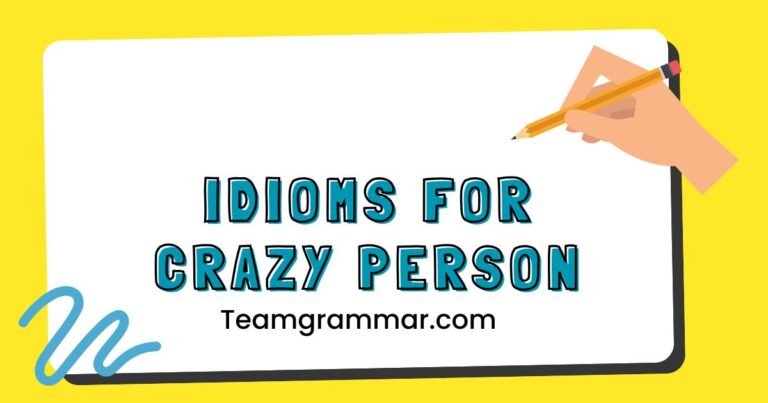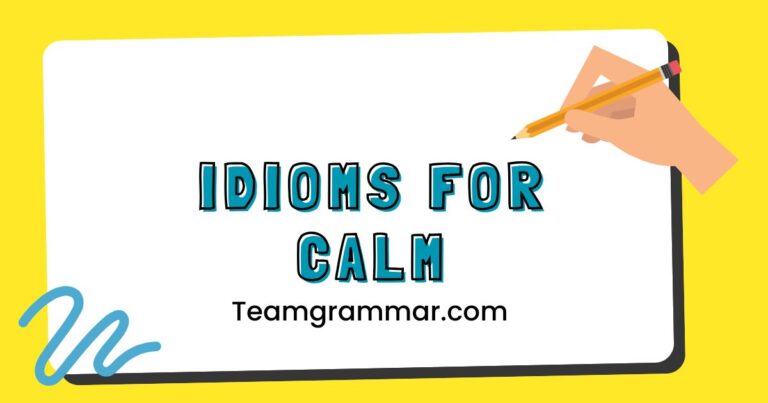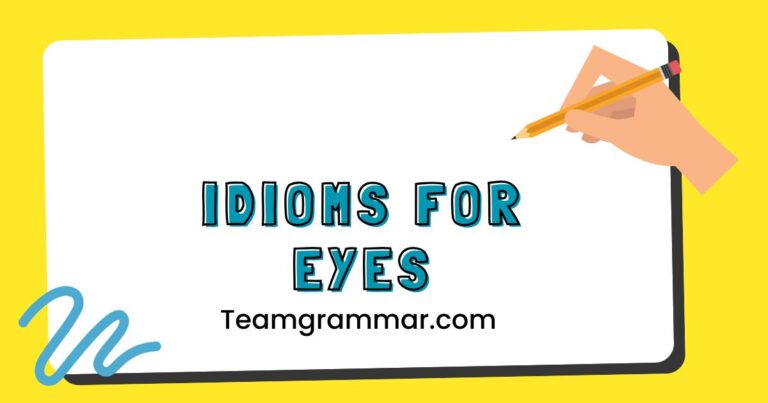49 Idioms for Leadership: A Comprehensive Guide
Understanding and using idioms effectively can significantly enhance your communication skills, especially in leadership roles. Idioms add color and nuance to language, allowing leaders to convey complex ideas concisely and memorably.
This article explores a wide range of idioms relevant to leadership, providing definitions, examples, and practical exercises to help you master their usage. Whether you are a seasoned executive or an aspiring leader, this guide will equip you with the linguistic tools to inspire, motivate, and connect with your team more effectively.
Table of Contents
- Introduction
- Definition of Idioms for Leadership
- Structural Breakdown of Leadership Idioms
- Types and Categories of Leadership Idioms
- Idioms Related to Vision and Strategy
- Idioms Related to Decision-Making
- Idioms Related to Motivation and Inspiration
- Idioms Related to Teamwork and Collaboration
- Idioms Related to Communication
- Idioms Related to Problem-Solving
- Idioms Related to Accountability
- Examples of Leadership Idioms
- Usage Rules for Leadership Idioms
- Common Mistakes When Using Leadership Idioms
- Practice Exercises
- Advanced Topics in Leadership Idioms
- FAQ: Frequently Asked Questions
- Conclusion
Definition of Idioms for Leadership
Anidiomis a phrase or expression whose meaning cannot be understood from the ordinary meanings of the words within it. Instead, an idiom has a figurative meaning that is known through common usage.Idioms for leadershipare specific expressions that relate to concepts, skills, or situations encountered in leadership roles.
These idioms often encapsulate complex ideas about strategy, motivation, teamwork, and decision-making into concise and memorable phrases. Understanding and using these idioms can significantly enhance a leader’s communication effectiveness, allowing them to connect with their team on a deeper level and convey their message more persuasively.
Idioms are classified as a type of figurative language, distinct from literal language. Their function is to add color, emphasis, and cultural context to communication.
In the context of leadership, idioms can serve to inspire, motivate, provide clarity, and foster a sense of shared understanding. They are used in a variety of settings, from formal presentations to informal team meetings, and can be particularly effective in simplifying complex concepts or conveying nuanced emotions.
Structural Breakdown of Leadership Idioms
The structure of leadership idioms can vary widely, but many follow common patterns. Some are based on metaphors, using concrete images to represent abstract ideas.
For example, “to steer the ship” uses the image of a ship’s captain guiding the vessel to represent a leader directing an organization. Others rely on similes, making comparisons using “like” or “as,” such as “to be as sharp as a tack,” indicating intelligence and readiness.
Still others are based on common experiences or cultural references, providing a shared understanding that enhances communication.
Idioms can be composed of various parts of speech, including nouns, verbs, adjectives, and adverbs. The key is that the combination of these words creates a meaning that is different from the literal interpretation.
For instance, “to think outside the box” uses the nouns “box” and “thinking,” the preposition “outside,” and the verb “think” to convey the idea of creative and unconventional problem-solving. The structure often contributes to the idiom’s memorability and impact, making it a valuable tool for effective communication.
Furthermore, the grammatical structure of an idiom is typically fixed. While some idioms may allow for slight variations, changing the word order or substituting words can alter or destroy the idiom’s intended meaning.
For example, saying “to box outside the think” makes no sense and completely loses the original idiom’s impact. Therefore, it is crucial to learn and use idioms accurately to maintain their effectiveness.
Types and Categories of Leadership Idioms
Leadership idioms can be categorized based on the specific leadership skills or concepts they represent. Below are several categories, each with its own set of common idioms.
Idioms Related to Vision and Strategy
These idioms describe the ability to see the big picture, set goals, and create a plan for the future. They often involve metaphors of sight, direction, and foresight.
Idioms Related to Decision-Making
These idioms focus on the process of making choices, weighing options, and taking action. They often involve metaphors of balance, risk, and judgment.
Idioms Related to Motivation and Inspiration
These idioms describe the ability to energize and encourage others, fostering a positive and productive work environment. They often involve metaphors of energy, enthusiasm, and encouragement.
Idioms Related to Teamwork and Collaboration
These idioms focus on the importance of working together, sharing ideas, and supporting each other. They often involve metaphors of cooperation, harmony, and unity.
Idioms Related to Communication
These idioms describe the ability to convey ideas clearly and effectively, listen attentively, and build rapport. They often involve metaphors of clarity, understanding, and connection.
Idioms Related to Problem-Solving
These idioms focus on the ability to identify, analyze, and resolve issues effectively. They often involve metaphors of solutions, innovation, and resourcefulness.
Idioms Related to Accountability
These idioms describe the importance of taking responsibility, owning mistakes, and delivering on promises. They often involve metaphors of ownership, integrity, and reliability.
Examples of Leadership Idioms
The following tables provide examples of leadership idioms, categorized by the leadership skill or concept they represent. Each table includes the idiom, its meaning, and an example sentence to illustrate its use.
Table 1: Idioms Related to Vision and Strategy
This table provides idioms that describe the ability to see the big picture, set goals, and create a plan for the future. These idioms are often used to inspire confidence and convey strategic thinking.
| Idiom | Meaning | Example Sentence |
|---|---|---|
| See the big picture | Understand the overall context and long-term implications | A good leader needs to see the big picture to make informed decisions. |
| Keep your eye on the ball | Stay focused on the main goal | It’s easy to get distracted, but we need to keep our eye on the ball and finish the project on time. |
| Lay the groundwork | Prepare the foundation for future success | The team is laying the groundwork for a new marketing campaign. |
| Map out a strategy | Develop a detailed plan of action | Before we start, let’s map out a strategy to ensure we’re all on the same page. |
| Chart a course | Set a direction or path to follow | The CEO is charting a course for the company’s future growth. |
| Have a bird’s-eye view | Have a comprehensive perspective | From her position, she has a bird’s-eye view of the entire operation. |
| Long-term vision | A plan for the distant future | The company’s long-term vision includes expanding into new markets. |
| Think ahead | Anticipate future needs and challenges | We need to think ahead and prepare for potential disruptions. |
| On the horizon | Likely to happen or appear soon | There are new opportunities on the horizon for our team. |
| A game plan | A strategic approach to achieve a goal | The coach developed a game plan to win the championship. |
| Strategic roadmap | A detailed plan outlining strategic goals and initiatives | The leadership team presented a strategic roadmap for the next five years. |
| Future-proof | Design or adapt something to be resilient to future changes | We need to future-proof our technology to stay competitive. |
| Look down the road | Consider the future implications of current actions | When making decisions, it’s important to look down the road. |
| Set the stage | Prepare the environment for something to happen | The new policies set the stage for increased productivity. |
| Visionary leader | A leader with a clear and inspiring vision | He is known as a visionary leader for his innovative ideas. |
| Blue sky thinking | Creative and unrestricted brainstorming | The team engaged in blue sky thinking to generate new product ideas. |
| Raise the bar | Set higher standards or expectations | We need to raise the bar to achieve excellence. |
| Stay ahead of the curve | Remain innovative and competitive | To succeed, we must stay ahead of the curve in technological advancements. |
| Think outside the box | Approach problems with creativity and innovation | To solve this challenge, we need to think outside the box. |
| Get the ball rolling | Start a process or initiative | Let’s get the ball rolling on this project to meet the deadline. |
| Keep the momentum going | Maintain progress and enthusiasm | We need to keep the momentum going to reach our goals. |
| Strategic alignment | Ensuring all efforts support the overall strategy | Strategic alignment is crucial for achieving our objectives. |
| See the forest for the trees | Understand the overall situation without getting lost in details | It’s important to see the forest for the trees when managing a large project. |
| Take a long-term view | Consider the distant future when making decisions | We need to take a long-term view to ensure sustainable growth. |
Table 2: Idioms Related to Decision-Making
This table provides idioms that focus on the process of making choices, weighing options, and taking action. These idioms are useful for conveying the importance of thoughtful and decisive leadership.
| Idiom | Meaning | Example Sentence |
|---|---|---|
| Call the shots | Make the important decisions | As the team leader, she gets to call the shots on this project. |
| Weigh the options | Consider all possible choices before making a decision | We need to weigh the options carefully before committing to a solution. |
| Take the plunge | Make a bold decision or take a risk | After much deliberation, he decided to take the plunge and start his own business. |
| On the fence | Undecided or hesitant | I’m still on the fence about whether to accept the job offer. |
| Bite the bullet | Face a difficult or unpleasant situation with courage | We have to bite the bullet and implement the necessary changes. |
| Cross that bridge when we come to it | Deal with a problem when it arises | Let’s not worry about the logistics now; we’ll cross that bridge when we come to it. |
| Think on your feet | Make quick decisions in response to unexpected events | A good leader must be able to think on their feet in a crisis. |
| Go with your gut | Trust your intuition or instinct | Sometimes you just have to go with your gut when making a decision. |
| Make a judgment call | Make a decision based on your own assessment | The manager had to make a judgment call to resolve the dispute. |
| Two cents | An opinion or suggestion | If I may add my two cents, I think we should consider this option. |
| Take the bull by the horns | Confront a difficult situation directly and confidently | The new CEO decided to take the bull by the horns and address the company’s financial problems. |
| Make a snap decision | Make a quick, often impulsive decision | In that situation, he had to make a snap decision to prevent further damage. |
| Call the shots | Make important decisions or give orders | As the project manager, she gets to call the shots on this project. |
| Carte blanche | Complete freedom to make decisions | The board gave the CEO carte blanche to restructure the company. |
| Split the difference | Compromise to reach an agreement | To settle the negotiation, they decided to split the difference. |
| Cut your losses | Stop investing in something that is failing | The company decided to cut their losses and discontinue the project. |
| Toe the line | Conform to rules or standards | Employees are expected to toe the line and follow company policies. |
| The buck stops here | Accept ultimate responsibility | As the leader, he knew that the buck stops here. |
| Back to the drawing board | Start over with a new plan | If this approach doesn’t work, we’ll have to go back to the drawing board. |
| At a crossroads | At a point where a decision must be made | The company is at a crossroads and needs to decide its future direction. |
| Bite the bullet | Endure a difficult or unpleasant situation | We had to bite the bullet and lay off some employees. |
| Take the high road | Choose the morally correct path | In that situation, it’s best to take the high road. |
| Jump the gun | Act prematurely without thinking | He jumped the gun by announcing the deal before it was finalized. |
| Play your cards right | Act strategically to achieve a desired outcome | If you play your cards right, you can secure the promotion. |
Table 3: Idioms Related to Motivation and Inspiration
This table provides idioms that describe the ability to energize and encourage others, fostering a positive and productive work environment. These idioms are essential for creating a motivated and engaged team.
| Idiom | Meaning | Example Sentence |
|---|---|---|
| Light a fire under | Motivate or energize someone | The coach tried to light a fire under the team before the big game. |
| Keep spirits up | Maintain a positive attitude | The leader worked hard to keep spirits up during the difficult project. |
| Go the extra mile | Exceed expectations and put in extra effort | The team is willing to go the extra mile to ensure customer satisfaction. |
| Give a pat on the back | Offer praise or encouragement | The manager gave a pat on the back to the employee for their hard work. |
| Lead by example | Demonstrate the desired behavior or values | A good leader always leads by example. |
| Rally the troops | Gather and motivate a group of people | The CEO rallied the troops to face the challenges ahead. |
| Raise morale | Improve the overall mood and enthusiasm | The company organized a team-building event to raise morale. |
| Keep your chin up | Stay positive and optimistic | Even when things get tough, it’s important to keep your chin up. |
| Pep talk | A speech intended to motivate or encourage | The coach gave the team a pep talk before the game. |
| Set the tone | Establish the mood or atmosphere | The leader set the tone for a positive and productive meeting. |
| Put your heart into it | Dedicate yourself wholeheartedly to a task | If you put your heart into it, you can achieve anything. |
| Inspire confidence | Make others feel confident in their abilities | A good leader should inspire confidence in their team. |
| Spark innovation | Encourage new ideas and creativity | The company invested in research to spark innovation. |
| Fan the flames | Encourage enthusiasm or excitement | The speaker’s words fanned the flames of passion in the audience. |
| Motivate from within | Inspire intrinsic motivation | The best leaders know how to motivate from within. |
| Empower others | Give people the authority or power to do something | The manager sought to empower others by delegating responsibilities. |
| Put a spring in someone’s step | Make someone feel energetic and happy | The good news put a spring in her step. |
| Energize the team | Boost the team’s enthusiasm and motivation | The new initiative helped to energize the team. |
| Be a driving force | Be a strong influence for progress | He was a driving force behind the company’s success. |
| Light the way | Guide or inspire others | The mentor helped to light the way for young professionals. |
| Set the pace | Establish the speed or rhythm of progress | The project manager set the pace for the team’s work. |
| Keep the faith | Maintain hope and optimism | Even in difficult times, it’s important to keep the faith. |
| Lift someone up | Encourage and support someone | The coach tried to lift up his players after a tough loss. |
| Spread enthusiasm | Share your excitement and passion with others | Her positive attitude helped to spread enthusiasm throughout the office. |
Table 4: Idioms Related to Teamwork and Collaboration
This table highlights idioms that focus on the importance of working together, sharing ideas, and supporting each other. These idioms are crucial for building strong and effective teams.
| Idiom | Meaning | Example Sentence |
|---|---|---|
| On the same page | In agreement or understanding | It’s important that everyone is on the same page before we start the project. |
| Pull together | Work together towards a common goal | The team had to pull together to meet the deadline. |
| Two heads are better than one | Collaboration leads to better ideas and solutions | Let’s brainstorm together; two heads are better than one. |
| In sync | Working harmoniously and efficiently | The team was in sync, which made the project run smoothly. |
| Carry the ball | Take responsibility for a task or project | She’s willing to carry the ball on this project. |
| Join forces | Combine efforts or resources | The two companies decided to join forces to develop a new product. |
| Work hand in glove | Work closely and cooperatively | The departments work hand in glove to achieve the company’s goals. |
| Row in the same boat | Share the same situation or fate | We’re all rowing in the same boat, so we need to support each other. |
| Team player | Someone who works well with others | He’s a great team player and always willing to help out. |
| All hands on deck | Everyone needs to help | With the deadline approaching, it’s all hands on deck. |
| Bridge the gap | Connect or reconcile differences | The mediator helped to bridge the gap between the two parties. |
| Meet halfway | Compromise to reach an agreement | The negotiators agreed to meet halfway to resolve the dispute. |
| Divide and conquer | Break a large task into smaller, manageable parts | They used a divide and conquer strategy to complete the project efficiently. |
| Band together | Unite to achieve a common goal | The community banded together to support the local school. |
| Chip in | Contribute to a common effort | Everyone chipped in to organize the fundraising event. |
| Shoulder to shoulder | Working closely together in support | The soldiers fought shoulder to shoulder to defend their country. |
| In concert | Working together harmoniously | The orchestra played in concert to create beautiful music. |
| Collective effort | A joint effort by a group of people | The project’s success was due to a collective effort. |
| Get on board | Join and support an initiative | We need to get everyone on board with the new strategy. |
| Work as a well-oiled machine | Function smoothly and efficiently as a team | The department works as a well-oiled machine to meet its targets. |
| Harmony in the workplace | A pleasant and productive work environment | The manager promoted harmony in the workplace by encouraging open communication. |
| Cross-functional collaboration | Collaboration between different departments or teams | Cross-functional collaboration is essential for innovation. |
| Build consensus | Reach a general agreement | The leader worked to build consensus among the team members. |
| Support network | A group of people who provide emotional and practical support | Having a strong support network is crucial for overcoming challenges. |
Usage Rules for Leadership Idioms
Using idioms effectively requires understanding their specific meanings and contexts. Here are some rules to consider when using leadership idioms:
- Know the Meaning: Always ensure you fully understand the idiom’s figurative meaning before using it. Misusing an idiom can lead to confusion or miscommunication.
- Consider the Audience: Be mindful of your audience’s familiarity with idioms. Avoid using obscure or culturally specific idioms that may not be understood by everyone.
- Use Appropriately: Choose idioms that are relevant to the situation and appropriate for the tone of the conversation. Avoid using idioms in overly formal or technical contexts.
- Avoid Overuse: While idioms can add color to your language, using too many can make your speech sound unnatural or contrived. Use them sparingly and purposefully.
- Maintain Context: Provide enough context so that the idiom’s meaning is clear. If necessary, briefly explain the idiom’s meaning to ensure understanding.
- Grammatical Consistency: Ensure that the idiom fits grammatically within the sentence. Adjust the verb tense or pronoun agreement as needed.
For example, if you’re telling your team to stay focused, you might say, “Let’s keep our eye on the ball to ensure we meet our deadlines.” This is more engaging and memorable than simply saying, “Let’s stay focused.” However, if you’re addressing a group of international colleagues who may not be familiar with the idiom, it might be helpful to add, “By ‘keep our eye on the ball,’ I mean let’s stay focused on our main goal.”
Common Mistakes When Using Leadership Idioms
Even experienced speakers of English can make mistakes when using idioms. Here are some common errors to avoid:
- Literal Interpretation: Interpreting an idiom literally instead of understanding its figurative meaning.
- Incorrect Word Choice: Substituting the wrong word in an idiom, altering its meaning or making it nonsensical.
- Grammatical Errors: Using incorrect verb tenses, pronoun agreement, or word order within the idiom.
- Overuse: Using too many idioms in a single conversation or presentation, making your speech sound unnatural.
- Misunderstanding Cultural Context: Using idioms that are specific to a particular culture or region, leading to confusion.
Here are some examples of common mistakes and their corrections:
| Incorrect | Correct | Explanation |
|---|---|---|
| “He called the shoots.” | “He called the shots.” | “Shots” is the correct word in the idiom, referring to making important decisions. |
| “We need to weight our options.” | “We need to weigh our options.” | “Weigh” means to consider carefully, while “weight” is a noun referring to heaviness. |
| “She’s on the fence if she should take the job.” | “She’s on the fence about whether to take the job.” | The correct preposition is “about” when expressing uncertainty. |
| “They have to bite the bowl.” | “They have to bite the bullet.” | “Bullet” is the correct word in the idiom, referring to facing a difficult situation. |
| “Let’s keep our eyes on the ball.” | “Let’s keep our eye on the ball.” | The idiom uses “eye” in the singular to emphasize focus. |
Practice Exercises
Test your understanding of leadership idioms with these practice exercises. Choose the correct idiom to complete each sentence.
Exercise 1: Fill in the Blanks
Complete the following sentences with the appropriate leadership idiom from the provided list. Choose from: call the shots, think outside the box, keep your eye on the ball, on the same page, take the plunge.
| Question | Answer |
|---|---|
| 1. As the project manager, she gets to __________. | call the shots |
| 2. To solve this problem, we need to __________. | think outside the box |
| 3. It’s important to __________ to ensure we meet our goals. | keep your eye on the ball |
| 4. Before we start, let’s make sure everyone is __________. | on the same page |
| 5. After much consideration, he decided to __________ and start his own company. | take the plunge |
| 6. The board of directors let the CEO _______ when it came to restructuring the company. | call the shots |
| 7. To innovate, you have to ________ and dare to be different. | think outside the box |
| 8. It’s easy to get distracted, so we need to ________ to finish the project on time. | keep your eye on the ball |
| 9. The team collaborated closely to ensure they were ________ before the presentation. | on the same page |
| 10. After months of planning, she decided to ________ and launch her new product line. | take the plunge |
Exercise 2: Multiple Choice
Choose the correct meaning of the idiom in the following sentences.
| Question | Options | Answer |
|---|---|---|
| 1. The CEO decided to take the bull by the horns and address the company’s issues. | a) Ignore the problems, b) Confront the problems directly, c) Delegate the problems | b) Confront the problems directly |
| 2. We need to rally the troops to meet the upcoming deadline. | a) Dismiss the employees, b) Motivate the team, c) Postpone the deadline | b) Motivate the team |
| 3. The manager always leads by example, which inspires the team. | a) Gives orders, b) Demonstrates desired behavior, c) Delegates tasks | b) Demonstrates desired behavior |
| 4. The company chose to cut its losses and discontinue the failing project. | a) Invest more money, b) Stop investing in the project, c) Re-evaluate the project | b) Stop investing in the project |
| 5. It’s crucial to stay ahead of the curve in this rapidly changing industry. | a) Fall behind competitors, b) Remain innovative and competitive, c) Maintain the status quo | b) Remain innovative and competitive |
| 6. As the team leader, he always tries to light a fire under his team. | a) Criticize the team, b) Motivate or energize the team, c) Ignore the team’s needs | b) Motivate or energize the team |
| 7. The two companies decided to join forces to develop a new product. | a) Compete against each other, b) Combine efforts or resources, c) Operate independently | b) Combine efforts or resources |
| 8. Everyone needs to chip in to ensure the success of the fundraising event. | a) Ignore the event, b) Contribute to a common effort, c) Criticize the event | b) Contribute to a common effort |
| 9. We need to bridge the gap between the two departments to improve communication. | a) Ignore the differences, b) Connect or reconcile differences, c) Increase the separation | b) Connect or reconcile differences |
| 10. The negotiations stalled, and they couldn’t meet halfway on the terms. | a) Agree completely, b) Compromise to reach an agreement, c) Refuse to negotiate | b) Compromise to reach an agreement |
Exercise 3:
Advanced Topics in Leadership Idioms
For those looking to deepen their understanding and usage of leadership idioms, here are some advanced topics to explore:
- Historical Context: Research the origins and historical context of specific leadership idioms to gain a deeper understanding of their meanings and cultural significance.
- Cross-Cultural Comparisons: Compare leadership idioms across different languages and cultures to identify similarities and differences in leadership styles and values.
- Idioms in Literature and Speeches: Analyze how idioms are used in famous speeches, books, and articles about leadership to understand their impact on communication.
- Creating New Idioms: Experiment with creating your own leadership idioms to express unique ideas or perspectives. Test these idioms with your team and gather feedback on their effectiveness.
- Idioms and Emotional Intelligence: Explore the connection between idioms and emotional intelligence, focusing on how idioms can be used to convey empathy, build rapport, and manage conflict.
For example, studying the historical context of the idiom “lead by example” reveals its roots in ancient military strategy, where leaders were expected to be at the forefront of battles to inspire their troops. This understanding can deepen your appreciation for the idiom’s enduring relevance in modern leadership.
FAQ: Frequently Asked Questions
Conclusion
Mastering idioms for leadership is a valuable skill that can significantly enhance your communication effectiveness and impact. By understanding the meanings, usage rules, and common mistakes associated with leadership idioms, you can confidently incorporate them into your daily interactions, presentations, and written communication.
Whether you’re inspiring your team, making critical decisions, or fostering collaboration, idioms can help you convey your message more persuasively and connect with your audience on a deeper level. Embrace the power of idiomatic language and unlock your full potential as a leader.







